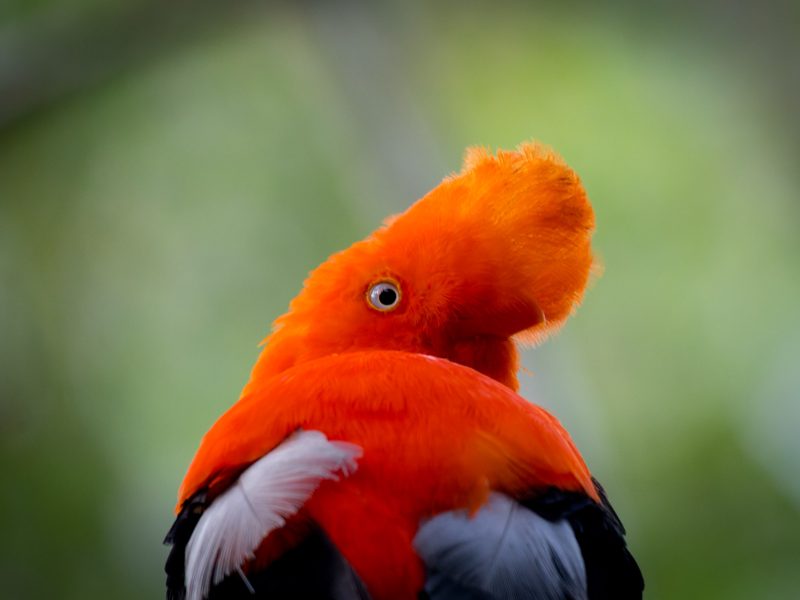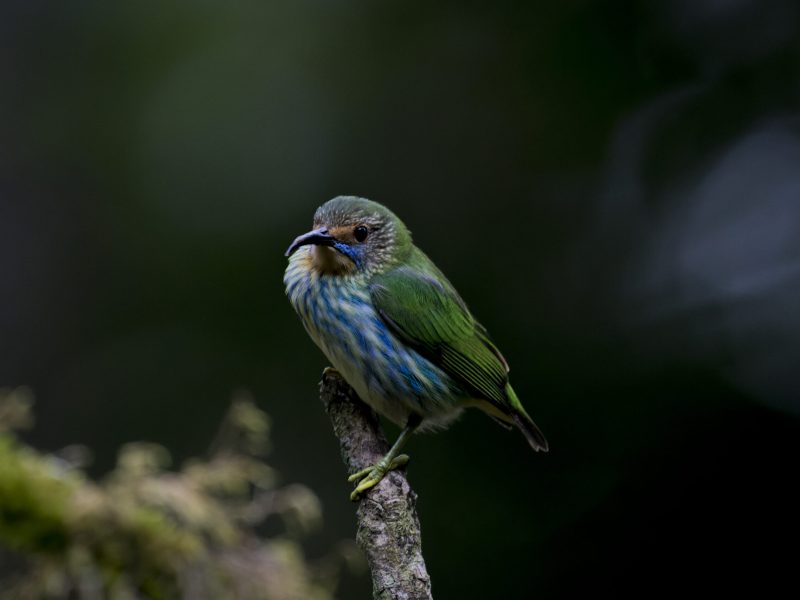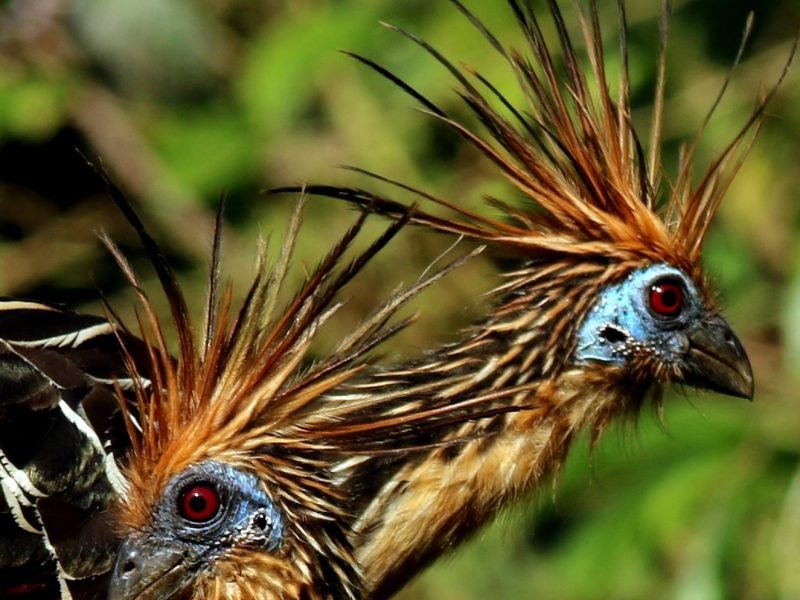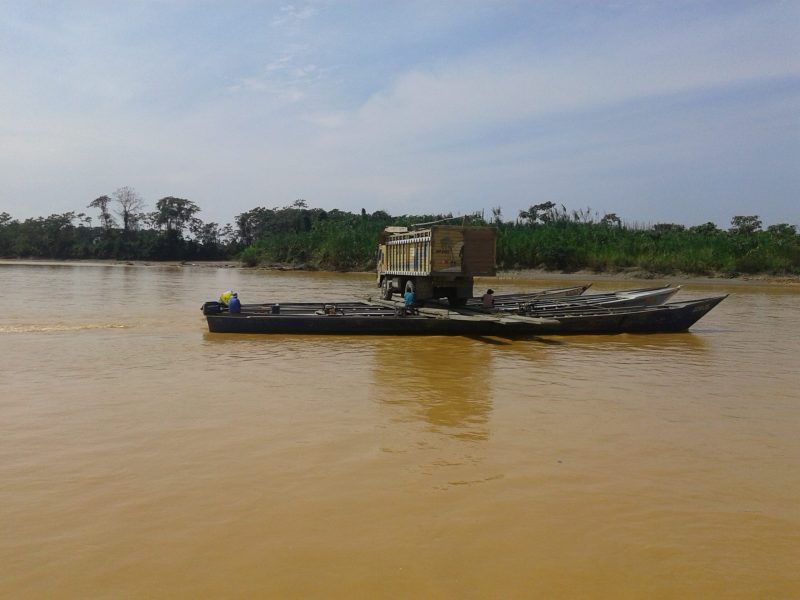HIGHLANDS-ANDEAN FOOTHILLS-LOWLANDS: BIRDWATCHING PERU
- Tour Type
- Recommended Ages
- Duration of the tour
- Group size
- Information
- Itinerary
- Includes / Does not include
- Gallery
Tour Details
Why Peru?
Peru is a megadiverse country located in South America, a destination that houses Machu Picchu and a section of the Amazon rainforest, with diverse geography that includes a coastal, Andean, highland, Amazonian, and Antarctic region. It has 84 of the 117 life zones in the world, and its territory is divided into three natural regions. The coast occupies 11% of the national territory, the Sierra (Andean region) occupies 30%, and the Amazon rainforest occupies the remaining 59%. Peru is an Amazonian country. Ecotourism activities in Peru and the enjoyment of nature observation have become an increasingly popular activity in the local, national, and international market, such as birdwatching in natural environments protected by the state across the country. Imagine traveling to a country that has 1879 species of birds (SACC checklist), a country where you could find more birds than in North America and Europe combined, a country that is the first home of endemic birds throughout South America, including over four hundred species that have subspecies.
Our Peruvian tour leader is a birding expert and an accredited naturalist who will ensure that your trip through this varied and beautiful landscape is full of birding and wildlife excellence.
General Information
Trip date: from April to December
Place where the tour begins: Cusco
Place where the tour end: Puerto Maldonado
TOUR BRIEFLY
Tour Date: from April to December
Tour Duration: 10 Days
Expected Birds Species: 400 to 450 species
Expected Mammal Species: 10 to 15
Altitude: 3,822m/12,539ft to 150m/492ft
Photographic Opportunity: Excellent
Local Guides: Birding Guide. Miguel Garcia
Other staff: For 3 or more guests catering staff will be provided for picnic breakfasts and lunch in prime birding locations.
Note Regarding single supplements
Single occupancy can be arranged, based on room availability and at an extra cost of US $ … per night.
Trip Grade: Gentle Hikes
You should prepare for certain travel factors in Peru, A few of the most important are elevation.
elevation of Cusco, Peru is approximately 3,399 meters or 11,152 feet above sea level, we need to be prepared to change our clothes during the trip, because we will change elevations and climes.
Insurance
We strongly advise that your travel insurance policies include medical assistance and evacuation we believe that it is ‘better to be safe than sorry!’ Should you decline to do so, we must state that we will in no way accept responsibility for expenses incurred should you require medical attention/evacuation while on holiday with us.
Accommodations
It is our policy to use the best available accommodation in each location. All hotels and lodges we use are government approved registered with the Tourism organism of Peru.
Temperature
Average Temperature in Fahrenheit and Celsius
| Place | High | Low |
| Lima | 80.6 F / 27 C | 59 F /15 C |
| Cusco | 66.2 F / 19 C | 32 F / 0 C |
| Madre de Dios | 82.4 F / 28 C | 68 F / 20 C |
Clothing
This trip departs in April which is generally a dry and cool time of the year but you may encounter light rain or damp condition. Evenings may be cool and you will certainly have many early mornings starts so will need some warm layers. The key to being comfortable is to adopt a system of several layers rather than one item of bulky warm clothing. Sun hats are an essential item, with a wide brim and something to protect your neck. Temperatures can drop very quickly in the evening and early morning and at altitude and you may again need to put on a number of layers.
Clothing Checklist
- Walking boots for hiking
- Comfortable shoes for camp
- Waterproof jacket best made with breathable, waterproof
- Fabric Waterproof over-trousers best made with breathable waterproof fabric.
- Lightweight down jacket for colder evenings / mornings or in case of cold snap trekking trousers.
- T-shirt / underskirts.
- Long sleeved shirts to prevent sunburn on your arms and keep airborne biting insect at day, thermal underwear.
- You may like to chance into this in the evening or have it to sleep in micro-fleece: warm, jacket, thick, sock, etc.
- Sun hat whit adequate protection for your neck smart/casual clothes for air travel
Equipment and Accesories
- Small day pack
- Sunglasses and retainers, if you wear glasses.
- Bring a spare pair Headlamp or
- Bring spare batteries
- Anti-bacterial hand gel, very useful for washing hands when no water is available
Electricity
The standard voltage in Peru is 220-240 volts. Most American appliances (except hairdryers) now have built-in convert- ers, so you only need to worry about bringing adapters. You will often find two pin sockets in bathrooms (type C). In most other rooms’ sockets are generally the round-three pin variety (type D). To be safe, take a universal travel adaptor
Brief Itinerary
Day 01: Cusco
Day 02: Cusco- Cock of the Rock Lodge (Manu Road)
Day 03: Cock of the Rock Lodge surroundings
Day 04: Lower Manu road – Bio Manu Lodge
Day 05: Bio Manu Lodge
Day 06: Bio Manu Lodge – Manu Birding Lodge
Day 07: Manu Birding Lodge – Blanquillo clay lick – Manu Birding Lodge
Day 08: Manu Birding Lodge – Blanco oxbow lake – Manu Birding Lodge
Day 09: Manu Birding Lodge – Puerto Maldonado City
Day 10: Puerto Maldonado City (surroundings) Birding- Lima
Itinerary

In the southeastern part of Perú, is located Cusco, which has one of the airports at the highest altitude above sea level, at 3500 meters (11482.94 ft). We recommend acclimatizing for some people, so we will wait for you at the airport to transfer you to the hotel and provide an orientation of the trip.
Today, we will begin our birding trip in Cusco city and head towards Lake of Wacarpay. As we make our way through the empty streets, it will take us approximately forty minutes to reach the lake, which is a protected area for birds and has been designated as a Ramsar site (treaty Relating to Wetlands of International Importance especially as bird habitat). Here, we will have our first encounter with the resident birds of this place, including four out of the five high Andean ducks: Puna Teal, Yellow-billed Teal, Andean Duck, Cinnamon Teal, and Yellow-billed Pintail. The reeds surrounding the lake provide a home for the most colorful bird in the area, the Many-colored Rush-tyrant, as well as the elusive Wren-like Rushbird. Other notable species that we may observe include Yellow-winged Blackbird, Plumbeous Rail, and Common Gallinule. The vegetation in this area is also a habitat for the largest hummingbird in the world, the Giant Hummingbird, which appears to move slowly in flight due to its size. We may also spot other species such as Black-throated Flowerpiercer, Blue-and-yellow Tanager, Streak-fronted Thornbird, Hooded Siskin, Yellow-billed Tit-Tyrant, Golden-billed Saltator, lesser Horned Owl (which can occasionally be seen), Spot-billed Ground-Tyrant, and many more. As we journey through various ecological changes, we will encounter different species, which ensure the diversity of birds that we can observe through our binoculars. Some of the species we may see include American Kestrel, Variable Hawk, Creamy-crested Spinetail, Scarlet-bellied Mountain-Tanager, Hooded Mountain-Tanager, Great Thrush, Crimson-mantled Woodpecker, Golden-headed Quetzal, Crested Quetzal, and the largest raptors in the cloud forest such as Solitary Eagle and Black and Chestnut Eagle.


Peru is a country with a rich ancient culture and abundant wildlife, and when it comes to southern Peru, the Manu National Park boasts more than a thousand bird species. Today we are at our lodge in the cloud forest, where the colorful and melodious diversity of birds is incredible. During our tours, we will come across mixed flocks, where different species work together to forage at different levels of the vegetation. We may see tanagers like the Golden Tanager, Golden-eared Tanager, Silver-beaked Tanager, Paradise Tanager, Bay-headed Tanager, Blue-necked Tanager, along with Olive-backed Woodcreeper, Montane Foliage-gleaner, Slaty-capped Flycatcher, Gray-mantled Wren, Black-eared Hemispingus, Three-stripe Warbler, and many more, possibly all in a single mixed group. With a whole day to explore this area, we can search for specific spots where we can find some territorial birds, such as Spotted Barbtail, Black-streaked Puffbird, Ocher-faced Tody-Flycatcher, Andean Potoo, Lyre-tailed Nightjar, Bluish Flowerpiercer, Blue-winged Mountain-Tanager, and others. At night, we may find some owls around our lodge, such as the Rufescent Screech-Owl, Tawny-bellied Screech-Owl, and Band-bellied Owl.
Waking up in the middle of birdsong and being surrounded by them is what we offer on this tour. However, we need to continue our trip to the Bio Manu Lodge. There is a significant difference in altitude between our current location, Cock-of-the-rock, and Bio Manu Lodge. Like our previous experience, we will encounter an incredible diversity of birds, some of which we have already seen, while others will be new to us. The climate will change, becoming warmer, and the vegetation will become denser, allowing us to see different birds such as Slaty Antwren, Scale-crested Pygmy-Tyrant, Yellow-breasted Antwren, Rufescent Antshrike, Foothill Stipplethroat, Andean Motmot, Amazonian Umbrellabird, Gray-breasted Wood-wren, Golden-bellied Warbler, Dusky-cheeked Foliage-gleaner, Red-billed Scythebill, Green-and-gold Tanager, Chestnut-bellied Seedeater, Chestnut-bellied Seed-Finch, etc.


On the route we will visit the hummingbird feeders that lure more than twenty species of hummingbirds and that will add to our checklist. Today, we will leave by our car to get that hummingbird places where we can see : Golden-tailed Sapphire, Great-breasted Sabrewing, White-necked Jacobin, Gould's Jewelfront, Rufous-crested Coquette, and we have here great possibility to see the endemic Koepcke's Hermit and the jungle surround to the feeder also offers canopy species that we can see and photograph.
This strategic place where two great ecosystems come together, inheriting flora and fauna from both, is known as an ecotone. Bio Manu Lodge is located in the ecotone between the cloud forest and the lowlands, making it a perfect spot for birdwatching.
As we get closer to the riverbanks, we will encounter secondary forests that gradually become primary. During our walks, we will see bird species that inhabit both ecological niches, such as White-browed Antbird, Bluish-slate Antshrike, Pygmy Antwren, Gray Antwren, Dot-wing Antwren, Bamboo Antshrike, Great Antshrike, Gray Antbird, Chestnut-tailed Antbird, Blue-headed Parrot, Blue-headed Macaw, Chestnut-fronted Macaw, White-winged Becard, Yellow-crowned Tyrannulet, Gray-crowned Flycatcher, Black-tailed Trogon, and many others.
At sunset, we will hear the forest-falcons start singing, and we might be lucky enough to spot Collared Forest-Falcon, Buckley's Forest-Falcon, or Slaty-backed Forest-Falcon. At night falls, we can look for owls such as Tawny-bellied Screech-Owl, Mottled Owl, and Black-banded Owl.
The tropical kingbird is common, the mixed flocks are combined with birds of medium and low canopy and we can enjoy some species like: Blue Dacnis, Blue-Necked Tanager, Black-faced Dacnis, Black-fronted Nunbird, Long-tailed Tyrant, Plumbeous Kite, Black-throated Antbird, Golden-bellied Warbler, Bluish-fronted Jacamar etc.
Without a doubt, one of the most relaxing and enjoyable parts of this tour is birdwatching from our motorboat. Today, we will be heading towards the Manu Birding Lodge, and the route itself will offer plenty of distractions and opportunities to observe birds that prefer the riverbanks. Along the way, we may see species such as the Fasciated Tiger-Heron (which tends to be found near water currents), Cocoi Heron, Capped Heron, Snowy Egret, Roseate Spoonbill, and Spotted Sandpiper, among others. This six-hour trip down the Madre de Dios River will take us through calm waters, where we may also spot other species such as the Large-billed Tern, Black Skimmer, Pied Plober, Yellow-billed Tern, Osprey, King Vulture, Drab-water Tyrant, Giant Cowbird, Olive Oropendolas in flight crossing the river, Orinoco Goose, Muscovy Duck, and more.
After arriving at the Manu Birding Lodge in the afternoon, we can relax and enjoy watching some hummingbirds at the garden, such as the Butterfly Coquetta, White-chinned Sapphire, Rufous Hermit, and others.

Today, we will start early and take a motorized boat to the clay lick of Blanquillo, which is a 45-minute downriver journey. Here, we will witness a fascinating and colorful show where the largest macaws in the Amazon jungle of Peru gather to eat clay and socialize. Some of them may even form couples for life because they are monogamous. From the blind house, we can enjoy this amazing party. To reach this place, we need to walk for about half an hour to the blind house from where we can spot the first parrots that have come around the clay wall to obtain the minerals they need for digestion. We can observe Mealy Parrots, Blue-headed Parrots, Yellow-crowned Parrots, and Orange-cheeked Parrots, which can easily exceed two hundred members. While we enjoy this show, we can have a delicious breakfast made by our expert cook.
After these green visitors descend to the clay wall, the largest Macaws of the Peruvian Amazon jungle, such as the Red and Green Macaws, often over a hundred in number, come down and offer us a spectacular sight. We may also see other species such as Ringed Kingfisher, White-winged Swallow, White-banded Swallow, Grey-capped Flycatcher, White-throated Toucan, Chestnut-eared Aracari, Crimson-crested Woodpecker, Lineated Woodpecker, Fork-tailed Palm-Swift, etc. After the show, we will return to our lodge and in the afternoon, we will explore the trail systems to make bird watching and look for birds that are specialists of the primary forest. We may encounter Great Jacamar, Band-tailed Manakin, Blue-backed Manakin, Blue-crowned Manakin, White-fronted Nunbird, Hairy-crested Antbird, Spot-backed Antbird, etc.
Today we will visit one of the most beautiful and strategic places for bird watching, the meander lakes. We will depart early from our lodge towards Blanco Lake, which is a meander lake where we can find a great abundance of bird species. We will navigate this lake on a catamaran, which will allow us to observe and photograph birds such as: Hoatzin, Purus Jacamar, Little Cuckoo, Greater Ani, Black-capped Donacobios, Ringed Kingfisher, Limpkin, and Purple Gallinule, among others.
After this activity, we will return to our lodge for lunch and then continue our birding journey along the trails. These trails have some leks of manakins, such as Band-tailed Manakin, Blue-backed Manakin, and Blue-capped Manakin. We will also visit the canopy tower to observe canopy birds and wait for the time to spot owls.


Our tour is coming to an end, and today we will travel to the city of Puerto Maldonado, which is approximately a seven-hour journey. However, during the boat ride, we will still have the chance to see some birds that we may have missed, as well as some that we have already seen, such as Southern Caracara, Muscovy Duck, Black Skimmer, Yellow-billed Tern, and Large-billed Tern. Our first stop will be at Boca Colorado. Boca Colorado used to be a popular tourist spot, but it has now been taken over by gold mining, and the flora and fauna have been affected. Here, we will take an express car for about one and a half hours to reach the port of Punkiri, from there, we will cross the Inambari River by motorboat and continue our journey to Puerto Maldonado city by car. We can then check in to our hotel after an amazing journey through the Andean foothills, cloud forest, and lowland.
Every journey must come to an end, and today we will bid farewell to Peru with one last birdwatching excursion near the airport. Due to deforestation, several species with widespread distribution have colonized these areas. During these couple of hours, we may spot a few new species, including Double-collared Seedeater, Red-breasted Blackbird, and possibly Black-throated Mango, Ruddy ground-Pigeon, and Greater yellow-headed Vulture. Other birds to keep an eye out for are the Scaly Pigeon, Rusty-margined Flycatcher, Hooded Tanager, and Grassland Sparrow.
Later we will take our fly to our houses.
